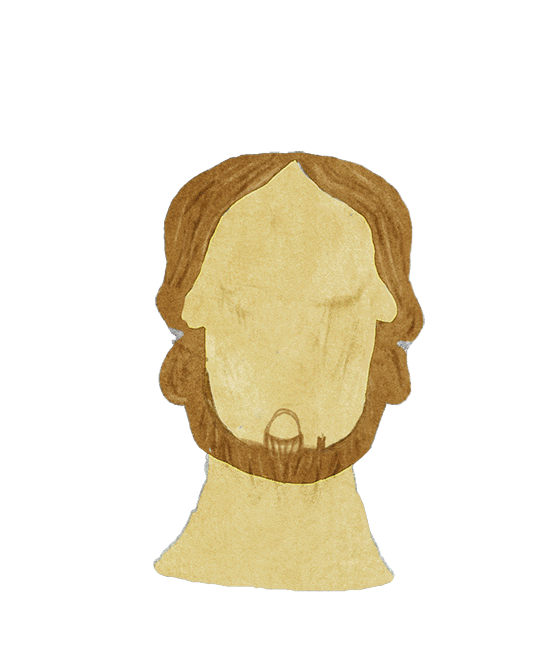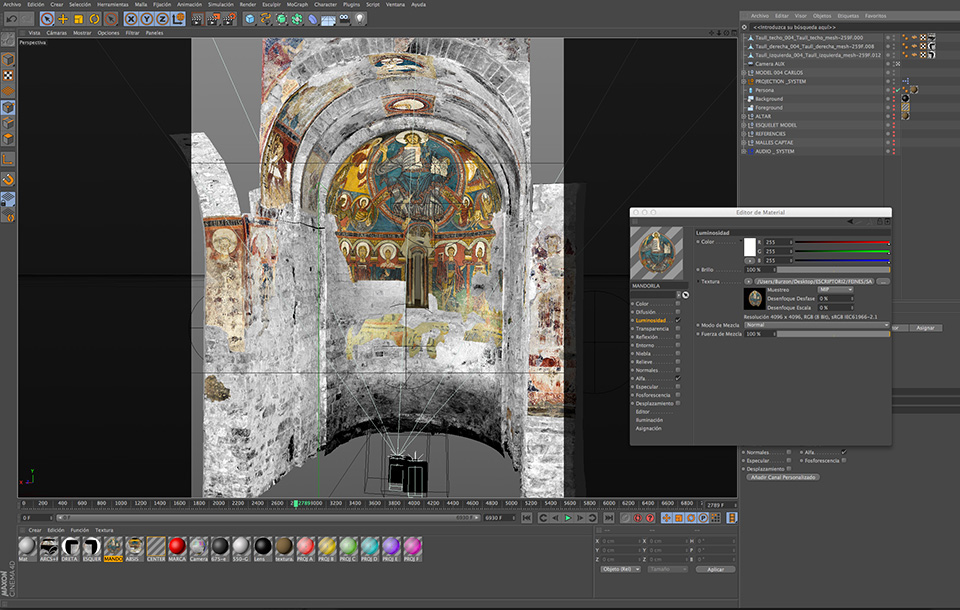
VIDEO MAPPING PERMANENT SANT CLIMENT DE TAÜLL
MACKING OF / TEASER
DESCRIPTION:
An innovative mapping recreates a Romanesque gem in Taüll
The paintings of the Church of Sant Climent of Taüll (Pyrenees), one of the most important gems of the Catalan Romanesque, has an innovative installation of a virtual copy that recreates the original frescoes through a mapping.
This project creates a museum space through the virtual projection of the original paintings (s.XII) of the apse and the entire presbytery currently conserved in the Museu Nacional d'Art de Catalunya (MNAC).
With six high definition projection integrated in the church, the visitor can observe the iconography which decorated the apse, thanks to the results of recent research and the innovative contribution of Burzon*Comenge in charge of the creation of the project and the animations, Playmodes in charge of the technical development and of the musical composition.
The mapping of Taüll is technology applied to Medieval art. In this sense, efforts were made to capture the historical essence in the content of the mapping. In this made-to-measure animation, research was carried out into how the painting of the time was done. Later on the painting was reproduced digitally layer by layer in order to animate the frescoes.
The projected image has been made to fit perfectly on top of the remains of paintings and the soundtrack manages to emotionally immerse the spectators in the mapping and it also includes sound effects recorded in the Vall de Boí.
For more information visit the website www.pantocrator.cat.

DIGITAL RESTORATION
The digital restoration we performed entailed recovering the work of art's original appearance and impact by repairing and reconstructing the missing parts of the fresco. To that end, we worked on the basis of high-definition photographs of the wall painting kept in the MNAC. We examined and dealt with the flaws attributable to the passage of time, as well as the marks (cracks, displacements, spots, etc.) caused by the work carried out to preserve the painting. The aim of the restoration process was not only to return the Pantocrator to all its aesthetic glory but also to give it back its meaning and make it easier to interpret, all the while respecting its historical value




DIGITAL RECONSTRUCTION
The digital reconstruction process comprised two stages. In the first, we reconstructed all the parts of the church's paintings that are poorly defined or have deteriorated a great deal with the passage of time. To that end, we made the most of even the smallest detail to completely reconstruct a figure, a frieze or an architectural element. The second stage revolved around the representation of the parts of which nothing remains on the church's walls but which we know were there, such as a group of apostles. We developed our representations of such figures on the basis of the traits of others that the fresco depicts





DIGITAL PAINTING AND REPAINTIN
We carried out our digital recreation of the paintings with animation in mind from the outset. That meant using layers to distribute the figures' elements, with each layer containing just one element. The procedure in question was the cornerstone of our animation.
The preserved paintings, meanwhile, were totally or partially repainted so as to separate all the base colours, shadows, lights and black profiles. That gave us full control over the layers, enabling us to manipulate and animate them individually


1123 RECREATION
The audiovisual production entitled Taüll 1123, a reference to the name of the church and the year in which it was consecrated, comprises three parts. The first shows the paintings on the church's walls, the second the paintings kept in the MNAC, and the third the recreation of the paintings in the church's central apse.
The starting point for our final recreation of the wall painting was the remains of the original, as they themselves provide a wealth of information, from small details to sizeable fragments of drapery, friezes and figures. We digitally produced the representation of the painting following the Romanesque pictorial technique, applying base colours, shadows, and black and white profiles



ANIMATION
The Sant Climent de Taüll mapping deliberately steers clear of the element of spectacle typical of projections cast onto buildings' façades. This is a specific mapping that recreates the church's wall paintings in an educational fashion, without overlooking aesthetics.
Initially, the mapping explains the iconographic hierarchy and the Master of Taüll's pictorial technique (reflected in the first part of the audiovisual production, up to the representation of the Pantocrator). The fresco's elements are subsequently displayed more surrealistically and the audiovisual production's mood becomes lighter, focusing on the beauty of the images. Finally, once the paintings' representations have been shown, viewers can compare them to the reality.
We used various 2D and 3D techniques for animation purposes. That enabled us to try out different options when reconstructing the paintings, adapting each technique to our requirements while adding value in visual terms. The video below, for example, shows how we repainted the Pantocrator so as to be able to animate it and fully control the different layers (colours, shadows, black profiles and lights).
The projection is beamed onto the surface of the church's central apse by means of six projectors, entailing the use and synchronisation of six different animation files. Watch the video

SOUNDTRACK
The process of creating music involved wide-ranging musicological research geared to reflecting aspects characteristic of the Middle Ages in terms of instruments and composition. That research was followed by work encompassing handmade instruments, composition and the development of digital tools. The result was a sound track based on sounds of the 12th and 21st centuries, striking a balance between the languages of medieval and contemporary music


MAPPING: TECHNICAL DESIGN
Technically, the mapping posed two major challenges. The first was that of minimising the visual impact of the technology present in the Church of Sant Climent de Taüll without compromising on image quality. The second consisted of integrating the remains in the apse with the originals in the MNAC.
Determining how many video projectors to use and where to position them was part of the technical process. We eventually decided to use six projectors, concealed from public view, in different positions and with different angles, to beam images onto the concave geometry of the central apse and to mix them properly.
We subsequently made an extremely accurate virtual copy of the church's apse, reflecting both its geometry and texture. At the same time, we took high-resolution photographs of the originals in the MNAC so as to be able to combine everything in a single 3D model




CREDITS
Project and audiovisual production:
Albert Burzon. Burzon*Comenge
Albert Burzon. Burzon*Comenge
Project and technical production:
Eloi Maduell. Playmodes
Eloi Maduell. Playmodes
Sound track:
Santi Vilanova. Playmodes
Santi Vilanova. Playmodes
Illustrations:
Albert Burzon
Xavi Mula
Albert Burzon
Xavi Mula
Animation:
Albert Burzon
Eloi Maduell
Albert Burzon
Eloi Maduell
3D modelling:
Carlos Padial
Carlos Padial
3D scanning:
Captae
Captae
Photography and texture mapping:
Josep Giribet. Calidos
Josep Giribet. Calidos
Concept and project management:
Eva Tarrida i Sugrañes. Arquitecta
Eduard Riu-Barrera. Arqueòleg
Albert Sierra i Reguera. Historiador
Eva Tarrida i Sugrañes. Arquitecta
Eduard Riu-Barrera. Arqueòleg
Albert Sierra i Reguera. Historiador
Pere Rovira i Pons. Restaurador
Jordi Camps i Sòria. Conservador
Jordi Camps i Sòria. Conservador
Lighting:
Antonio Sáinz. Haz Luz 17
Antonio Sáinz. Haz Luz 17
Painting restoration:
Mercè Marquès. Krom
Mercè Marquès. Krom
Archaeological excavation:
Isidre Pastor
Maite Rovira
Isidre Pastor
Maite Rovira
Engineering:
RC Enginyers
RC Enginyers

MORE INFO: www.pantocrator.cat


